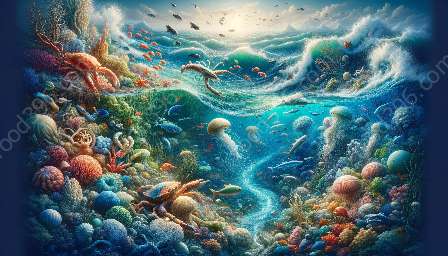The ocean is a vast and mysterious realm, with the deep sea holding some of the most intriguing and least explored ecosystems on our planet. Deep-sea ecology is a captivating field that encompasses the study of life forms, habitats, and environmental processes in the profound and dark regions of the ocean. This topic cluster aims to shed light on the wonders of deep-sea ecology, its link to oceanography, its impact on seafood production, and its relation to seafood science.
The Enigmatic World of Deep-Sea Ecology
The deep sea refers to the area of the ocean below 200 meters, where sunlight barely penetrates, and pressure is immense. Despite the inhospitable conditions, the deep sea hosts a remarkable diversity of life, from microscopic organisms to giant sea creatures. The unique characteristics of this environment, such as low temperatures, high pressure, and limited food supply, have led to the evolution of extraordinary adaptations and biological processes in deep-sea organisms.
Deep-sea ecosystems are characterized by hydrothermal vents, cold seeps, abyssal plains, and deep-sea trenches, each harboring specialized organisms and intricate food webs. These ecosystems play a crucial role in global nutrient cycling and offer valuable insights into the limits of life on Earth. Understanding deep-sea ecology is pivotal for conserving biodiversity, managing fisheries, and mitigating the impacts of human activities on the deep ocean.
Interplay with Oceanography
Deep-sea ecology and oceanography are intricately connected, as the physical and chemical properties of the deep ocean greatly influence the distribution and behavior of organisms. Oceanographic processes such as upwelling, thermohaline circulation, and ocean currents play a vital role in shaping deep-sea habitats and driving the productivity of deep-sea ecosystems. By studying the interactions between biological and oceanographic processes, scientists can unravel the complex dynamics of deep-sea ecosystems and forecast their responses to environmental changes.
Moreover, oceanographic research provides crucial data for mapping deep-sea regions, understanding the ocean floor topography, and identifying potential sites for deep-sea mining and resource exploitation. The collaboration between deep-sea ecologists and oceanographers is essential for obtaining a comprehensive understanding of the deep ocean and its ecological significance.
Impact on Seafood Production
Deep-sea ecology plays a pivotal role in seafood production by influencing the abundance, distribution, and life history traits of commercially valuable species. Deep-sea fisheries target species such as deep-sea cod, grenadiers, and orange roughy, which inhabit the cold and dark depths of the ocean. However, the sustainability of deep-sea fisheries is a topic of concern, as the long lifespan, slow growth rates, and low reproductive capacity of many deep-sea species make them highly vulnerable to overexploitation.
Understanding the ecological dynamics of deep-sea ecosystems is crucial for implementing effective fisheries management strategies and conserving deep-sea biodiversity. By integrating knowledge from deep-sea ecology, fisheries science, and marine policy, it is possible to develop sustainable practices that support the long-term viability of deep-sea seafood production while minimizing the impacts on the delicate balance of deep-sea ecosystems.
Connection to Seafood Science
Seafood science encompasses the study of seafood quality, safety, processing, and nutritional value, with a focus on both wild-capture and aquaculture products. Deep-sea ecology contributes to seafood science by providing insights into the ecological processes that shape the characteristics of deep-sea organisms, including their physiological adaptations, biochemical composition, and nutritional properties.
Researchers in seafood science investigate the impact of environmental factors on deep-sea seafood quality, assess the sustainability of deep-sea fisheries, and explore innovative technologies for deep-sea product development. By understanding the intricate relationships between deep-sea ecology, seafood production, and seafood science, scientists and industry professionals can work towards ensuring the responsible utilization of deep-sea resources and the delivery of high-quality, nutritious seafood products to global consumers.
Challenges and Conservation Efforts
Deep-sea ecosystems face numerous challenges, including the impacts of climate change, deep-sea mining activities, habitat destruction from bottom trawling, and pollution from anthropogenic sources. The slow growth rates and low resilience of deep-sea species make them particularly vulnerable to disturbances, emphasizing the need for robust conservation measures and sustainable management practices.
Conservation efforts in deep-sea ecology involve the establishment of marine protected areas, the development of ecosystem-based management approaches, and the implementation of international regulations to prevent the exploitation of vulnerable deep-sea habitats. Collaborative research initiatives, public awareness campaigns, and policy advocacy are critical components in safeguarding the ecological integrity of the deep sea and ensuring the persistence of its extraordinary biodiversity for future generations.
Exploring the Depths and Embracing the Complexity
Delving into the realm of deep-sea ecology offers a profound sense of wonder and discovery, as well as a profound appreciation for the intricate web of life that thrives in the darkness of the ocean depths. By integrating knowledge from oceanography, seafood production, and seafood science, we can gain a holistic understanding of the deep-sea environment and work towards sustainable utilization and protection of its resources. The challenges and mysteries of the deep sea beckon us to explore, learn, and conserve, ensuring that this enigmatic realm continues to inspire and astonish us.

